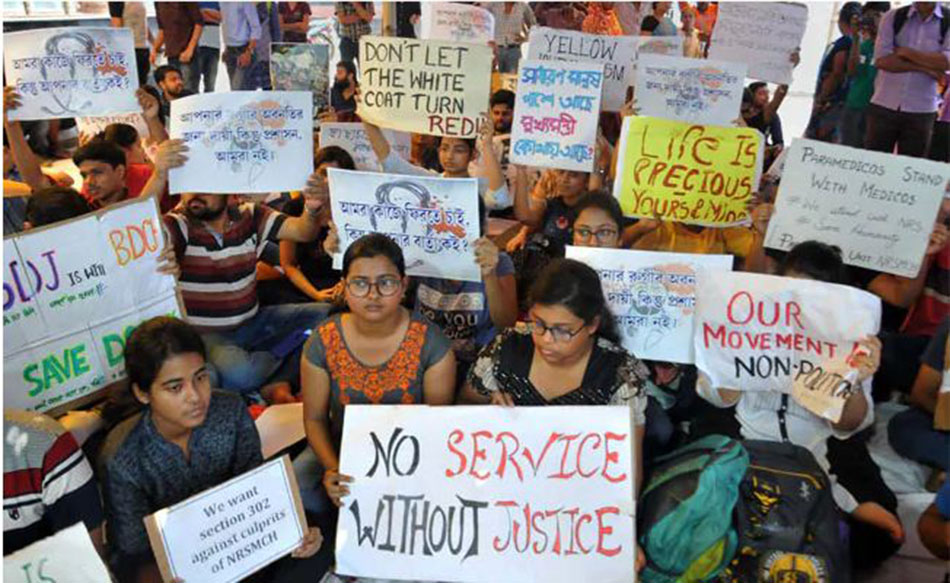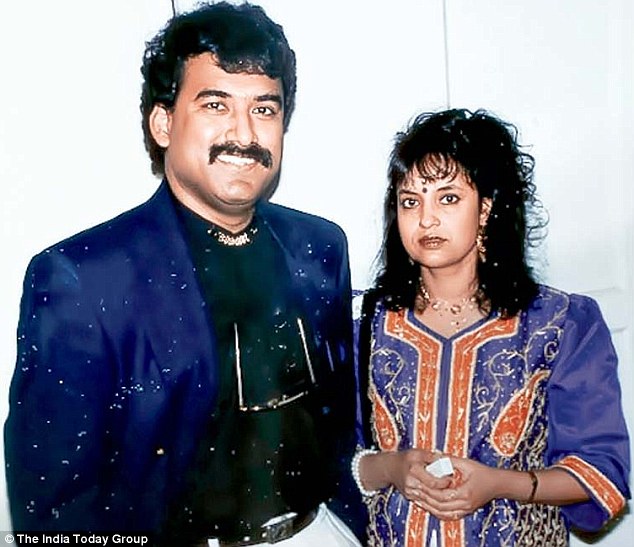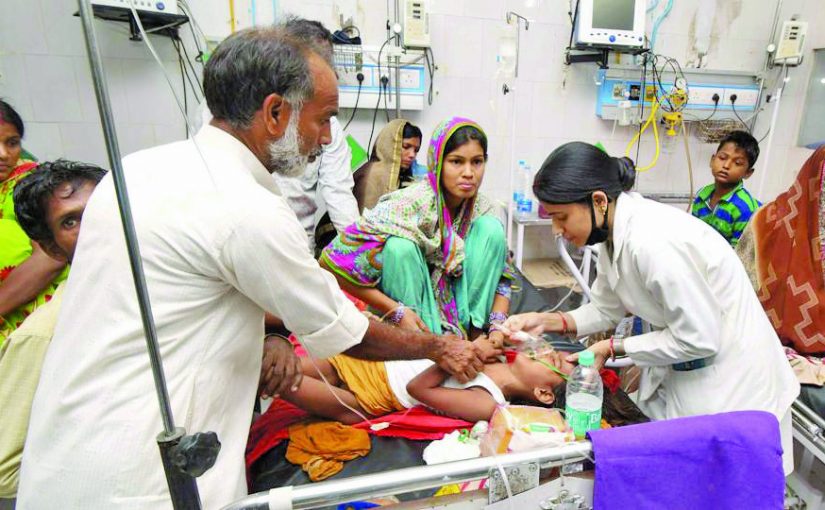NEGLIGENCE: Over a hundred children in a government hospital in Bihar have died of extreme encephalitis. The doctors are not even able to diagnose what caused it!
BY RAJAN NARAYAN
Doctors should be given security against angry relatives when things go wrong. But they should also be held accountable for their sins of omission and commission
I do believe that doctors should be given security against patients who turn violent. At the same time I believe that doctors should be accountable to patients. Doctors get beaten up because in the case of an unexpected death or injury they do not explain to the patient’s relative what went wrong. Even if they have made an honest mistake they should admit it to the patients.
The ground reality is that with honourable exception, doctors, particularly in government hospitals, are arrogant and indifferent towards poor patients. Everyone is screaming over the assault on some resident doctors in a government hospital in Kolkata. Indeed the Indian Medical Association has called for a country wide strike in sympathy with the doctors in Kolkata. Over the dadagiri of didi Mamta. But nobody in the medical community is talking about over a hundred children dying of extreme encephalitis in Bihar. Nobody talks about the images we see very often in national papers of relatives having to carry patients on cycles or hand carts because they don’t have access to ambulances in remote locations or because they can’t pay for the ambulance. In Goa the state-of-the-art ambulance equipped with life-saving equipment will arrive at your home if you call. But if you have the misfortune of not surviving the heart attack or stroke there is no transport to carry the body home.
Doctors are humans. They can make mistakes. But they have an obligation to tell their patients what their problem is and details of the treatment they are planning. They have to explain the side effects of not only an operation but even procedures carried out like CT scans. If you talk to your doctor friends they will tell you that they themselves have a CT scan or X-ray taken as rarely as possible because of the radiation that is emitted from these machines.
Which is why when you are having a CT scan or an MRI you are alone in a room in the MRI tunnel; even the technician, not to mention the doctor, are outside the room and safely out of the radiation zone. The MRI machine is so powerful that there are urban legends of people wearing something metallic going a little too close to the machine and getting sucked into the machine because of the magnetic waves.
I have been a victim of the most blatant medical negligence despite good intentions because of the bias and the ignorance of doctors. And of course the ego of the doctors which will not let them admit that they may have made a mistake. Way back in 1989 I got beaten up savagely on my spine by hired goons allegedly at the instance of the then speaker of the Goa Assembly Dayanand Narvekar. The then Head of Department of medicine Dr NGK Sharma put me on steroids in the belief that I had polymyositis which is a muscle wasting disease. Because I was in acute pain and was admitted as a VIP patient he probably was under pressure to increase the dosage of steroids to give me some relief. Though the GMC had a neurologist he was either not consulted or was too scared to contradict the opinion of the Head of Department of Medicine.

Over a period of 40 days the HOD of Medicine increased the steroid dosage to almost 80 milligrams a day. Steroids may be a wonder drug but a medical student knows that it should be used only in a very small quantities and that it has severe side effects. It happened coincidentally that the then Chief Minister of Goa Dr Wilfred D’Souza had come to visit me in my VIP room at the same time that my friend Dattaraj Salgaocar had also come. Dr Wilfred D’Souza, who was a veteran surgeon trained in United Kingdom, told me to get out of GMC and go to Mumbai as the GMC would kill me.
Fortunately for me Raj Salgaocar agreed to make all arrangements to shift me from the GMC to the Jaslok Hospital in Mumbai in which his brother-in-law was a senior consultant. Rightly fearing that the specialist in Mumbai would not take kindly to the criminally huge doses of steroid he had given me, in panic the doctor stopped the steroids completely. Which is against all rules as steroids have to be tapered off very slowly.
I went into a coma and had to be transported to Mumbai on a stretcher by flight for which they remove four rows of seats and tied the stretcher to the floor of the plane. The worst damage Dr Sharma did to me was a dubious discharge certificate which was signed by one of his senior residents. The discharge certificate said that I was suffering from polymyositis / peripheral alcoholic neuritis.
Always check your discharge certificates as doctors often use the word alcoholic even if you don’t drink to protect themselves.
At the Jaslok Hospital they conducted the entire range of tests for polymyositis but could not find any symptoms. But they were reluctant to advise me to withdraw from steroids because it was possible that by the time I had reached Mumbai the steroids had masked the symptoms. The superspecialists did not want to take the risk of the consequences of withdrawal from steroids. I was advised to taper the steroids and see what happens. The moment I brought the steroid level below 50 milligrams I used to get unbearable pain in the back.
I decided to take a second opinion from Dr Singhal who was considered the senior most neurologist in the country. I spent three months in Mumbai hospital. All the test were repeated. Dr Singhal like his counterpart in Jaslok would not admit the he did not know what was wrong with me. The greater the reputation of the consultant the less he is willing to admit that he cannot diagnose what is wrong with you. After all he has his reputation to consider. Over the next five years I went to every hospital in the country and to the Mecca of neurologists — the National Hospital for Neurology and Neurosurgery in London. Nothing happened and in the meanwhile the side effects of steroids became acute. Steroids cause water retention. This caused my weight to go up from an average of 60 kg to 180 kg. I was like a sumo wrestler. Both my eyes were affected and I had to get them operated. My bones became very weak and I used to have frequent fractures. My face swelled up like that of Lord Ganesh — in medical circles called a moon face. I continue to suffer terrible pain.
My agony ended by a happy coincidence in Bangalore. When I was returning from an eye operation in Madurai at the Arvind Netralaya, I decided to come to Goa via Bangalore. I had a fall at the Bangalore airport and had multiple fractures. I was admitted by friends in Bangalore ironically to the Mallya hospital owned by Vijay Mallya.
There was a young endocrinologist who had just returned from John Hopkins in New York considered one of the best hospitals in the world. He was not involved in the treatment of my fracture. But walking past he saw my huge weight and other symptoms. He came to know and said that if I continued taking steroids I would be dead in a month. I protested and told him that all the best neurologists had told me that if I stopped I would be dead in a week. “Don’t believe them. Come and climb the Mount Everest with me” said Dr Srikanta. He wanted me to detox from steroids. He warned that it would take six months and that it was a very risky dangerous procedure. In fact there was a cardiologist, a neurologist and a psychiatrist in the team.
Fortunately he took only four months. And all the effects of steroids on the body were halted. I did not need to take steroids any longer. My face had become normal. My weight came down from 180 kg to 30 kg. So much so my friend, the late Ashraf, could lift and carry me like a child. I owe my life to Dr Srikanta. But he is also responsible for the collapse of my gastro-intestinal system.
When I told him about the side effects, he said, he had completed his job of detox from steroids. I should go to a gastro specialist for my gastric problem which was a side effect of steroids thanks to the medical community and all the experts who kept me on steroids for five years. The quality of my life has become worse. Because of the trauma my body suffered I now have serious acid reflux syndrome.
More recently I went to Bangalore to the Aster hospital there on the insistence of a friend I went to meet the senior-most gastro expert in the country. He did the entire range of tests on me. At our very first meeting he asked me where I was from. When I told him I was from Goa his immediate response was that my gastric problems was because of drinking. To this doctor every Goan was a bevda. I did not notice at that time but because of his comment that I was an alcoholic the insurance company refused to reimburse my expenses.
My latest encounter with the medical community was with super specialist Dr Roy Patankar in Mumbai. Everyone in Goa and elsewhere suggested that he was the supreme authority on the subject of acid reflux. I did not know that he had left the Hinduja hospital which is a very well equipped hospital and had started his own nursing home which has no facilities at all. It started on a bad note when I asked for a receipt for the consultancy fee of `1,500. Perhaps I was the first patient to ask for a receipt.
I was admitted and sent for an MRI in a third hand substandard machine which had been out sourced. The technicians left me in the MRI tube and went off for tea. Leaving me in the machine for almost two hours. The button to alert the doctor and the technician that I was feeling suffocated was not working. Finally, when I was released I was taken back to the room. Where I discovered that the nurses were all untrained and could not even find a vein. When I protested to the superspecialist he told me to get myself admitted to Lilavati since I was making so many demands. He also insulted a good friend of mine who works as a medical reporter for a leading national paper.
There are many good doctors. There are doctors who care for their patients like Dr Francisco Colaço and Dr Oscar Rebello. There are many excellence surgeons like Dr Jorson D’Costa of the Neurology Super Specialty in the GMC. There are surgeons like Dr Rajesh Patil, and like Dr J P Tiwari who has even been doing kidney transplants in the GMC even though for a long time he had no assistant. There is Dr Ankush Desai, one of the best endocrinologists/diabetes experts in Goa, who discourages you from using insulin and asks you to change your diet instead. But there are an equal number of black sheep in the profession. Including the head of the department who refuse to accept a close friend had rabies and dumped him in the mental hospital. So while I sympathise with doctors and I believe that they should not be beaten up, I think doctors should also be made accountable. And hospitals should be held responsible for their sins of omission and commission.
STILL UNDECIDED…
TWO senior doctors at the GMC — Dilip Amonkar and Shantaram Surme — along with Shridhar Pai, owner of Pai Nursing Home, Vaddem, Vasco, were named accused in an alleged medical negligence case involving the death of a Vasco-based minor, Raveena Rodrigues.
The girl was admitted at Pai Nursing Home and was found to have acute appendicitis. Dr Amonkar was requested to perform the operation. He removed the appendix on July 3, 2010. Post-operative care was taken by Pai Hospital. Ms Ravina was discharged from Pai Hospital on July 5. Ravina suffered continuous pain, could not eat, and would throw up after drinking water. When Dr Surme was called and informed about the same he told her to carry on with the medicines given to her. When Ravina’s abdomen was found enlarging she was again admitted in the hospital on July 9. Dr Surme gave some injection and kept Ravina on drips at Pai Hospital and told the family that it was acidity. Dr Surme advised a sonography only on July 10, when there was no improvement. An ultrasound carried out at 6:30 pm revealed fluid in the abdomen which was confirmed to be blood. Thereafter, as per the advice of Dr Amonkar, Ravina was shifted to GMC Bambolim where she was operated on again by another doctor and where she eventually died on July 29, 2010.
Following her death, a case was filed by the girl’s parents, who suspected that their daughter was not given proper medical care. After a public outcry, the government formed an inquiry committee that found there was medical negligence.
In 2017 Additional Sessions Judge, South Goa, Margao, directed framing of charge against the petitioners under Section 304-A of IPC. An application against this order was brought by the doctors but was dismissed by the High Court in August 2017 which found that there were many prima facie issues that needed to be decided through trial:
Records revealed that no test was conducted before conducting the surgical operation — either by Dr Amonkar or Dr Surme. Dr Amonkar did not at any time ask to see the consent form or any reports.
Dr. Amonkar himself admitted that the operation theatre at Pai Nursing Home was not up to the mark and was in unhygienic condition. Statements by the nurse and the patients family showed Ms Ravina was not in extreme pain and was not in such a deteriorating condition that the appendix was going to burst which brought into question why Dr Amonkar did not shift her to GMC and carry out the operation there.
Dr Surme’s statement that he took blood from the patient for a blood test was contradicted. The nurse present with the patient flatly denies this could have happened.
The court also pointed out that when the patient was brought to the GMC Dr Amonkar said he was far away, at Amona in Bicholim. However, call records place him at Merces and later at Panjim.
The case is still pending….
HIGHEST COMPENSATION IN INDIA

In a landmark order, the Supreme Court on October 24, 2013, directed Kolkata’s AMRI Hospital and three of its doctors to pay an amount of 5.96 crore as compensation to Dr. Kunal Saha — a US-based Indian doctor — who lost his wife Dr. Anuradha Saha due to medical negligence in 1998. This judgment came around 15 years after his wife died owing to faulty medical treatment. The court ordered that he was entitled to 6% interest on the compensation amount from 1999 — a total of11.41 crore.
Noting that treatment with dignity was “not only a fundamental right” but “also a human right”, the court asked the Centre and the state government to “deal strictly” with doctors, hospitals and nursing homes found to be negligent with patients.
This is the highest amount ever awarded by an Indian court in a medical negligence case. The previous highest compensation amount was `1 crore, awarded by the SC to Prasanta Dhanaka in May 2009.
